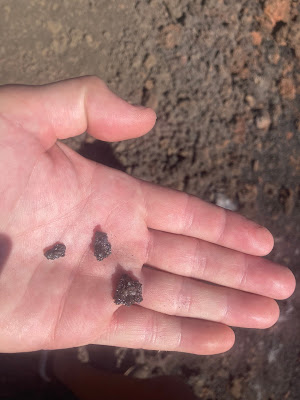December 29th, 2021
I signed up for a 16 kilometre day hike up one of six
volcanoes on Isabela
Island. Sierra Negra
last erupted in 2018, not long ago, but it is considered fairly safe, not one
to blow it’s top. It tends to have small
lava flows, if any that are visible on the surface, and may cause small
tremors.
I was picked up by a big truck with rows of seats in the
back with a wooden covered roof that chattered on our 40 minute drive up to the
volcano. The terrain morphed from an
arid, barren landscape with stunted bushes and grass to lush farmland thanks to
frequent mist falling from clouds at the higher altitude. There were about 10 tourists in the back of
the truck, and I looked around and did an assessment of our group, with the
aspect of a 16 km hike up a volcano in mind.
Behind me were a couple of thirty-year-old Germans who looked fit. In front of me were a few women of about the
same age but then I noticed some Ecuadorians.
One man looked to be about 240 pounds and another woman looked to be in
her mid-60s. Hmm…we may be a slow
group. Then I noticed a 4-5 year old boy
sleeping on his mother’s lap…oh dear.
Let’s see how this plays out.
Getting lusher as we ascended the road up the volcano.
At the entry gate, our guide gave us an overview of the hike
and we set off up a dirt road. The
family with the young boy had a push stroller and the first half a kilometre
was a bit bumpy. I questioned how far
they would make it but the road actually got smoother. In the end, they didn’t complete the hike and
I think that was their plan all along.
The guide stopped the group once in a while and explained a
few things about the flora and fauna, mostly the flora as there wasn’t a whole lot
of fauna apart from a few feral horses. An
interesting tidbit she told us were about the invasive guava trees. They were introduced by humans some 100 years
ago to provide fruit, but unfortunately, they just took off and have now
inundated the lower half of Isabela Island.
They are so dense that the shade out a lot of the shorter native plants
like ferns. The guava fruit has hundreds
of seeds and birds love the fruit, as do many other animals, and they end up
distributing the seed everywhere. The
giant tortoises get hooked on the sugar in the fruit and the guide claimed that
is causes the female tortoises to stop ovulating…not good.
We stopped at a few viewpoints of the caldera (a big
volcanic crater), supposedly the second largest in the World, measuring about 7
by 9 kilometres. The clouds were
spilling over the rim on the south side, where we came from which looked
awesome.
On the hike, I started chatting a couple of Swedes in their
late 20s or early 30s, Johan and Michaela and later to another young woman, Jennifer
from Colorado. All very nice and
interesting people which made the hike, even though it was relatively easy,
much more enjoyable.
A little after six kilometres into the walk, we reached an
open hut which provided some much needed respite from the sun as we are close
to the equator. After that, the trail
began to descend towards an area of volcanic rock. There was one large tree that seemed to be
out of place. The guide stated that it
was planted by whalers some 100+ years ago as a way to attract giant tortoises
to that area as they liked to sleep in the shade. Tortoises were an excellent fresh protein
source for long sea faring voyages in the 1800s as they can survive with no
food and water for upwards of a year!
Unfortunately, that meant that the majority of their population were
wiped out. In fact, a few of the
subspecies didn’t make it such as the Pinta Island Tortoise. Perhaps you heard about “Lonesome George”, the
last remaining survivor who died in 2012.
Soon we were walking on the black and rusty coloured lava
rock. The odd cactus was making a go of
it on this barren landscape, pretty impressive.
We reached the final viewpoint, and it did not disappoint. Even our guide (I forget her name) was
excited and she has hiked this route almost every day for the last year! And good for her, it sounded like this was a
life changing decision to take up this job.
She was recently divorced, and it sounded like she left a toxic
situation as she called her ex “el diablo”.
But she seems happy and has lost 70 pounds since she started this
gig. You go girl! Anyways, we could see the majority of the
north end of Isabela Island, Fernandina and Santiago and even some smaller
islands like Rabida.
After about 20 minutes, we returned to the hut for lunch and
then hiked back along the same route, descending back into the clouds to the
entrance point. We were back by about
1:30 pm, having started around 8 am. It
wasn’t an overly tough hike, but my feet were definitely ready for a rest.
That evening I met up with Chris Shelton, my former
co-worker who I coincidentally ran into yesterday, for dinner with the group he
was travelling with. It was a nice way
to end the day.
























No comments:
Post a Comment